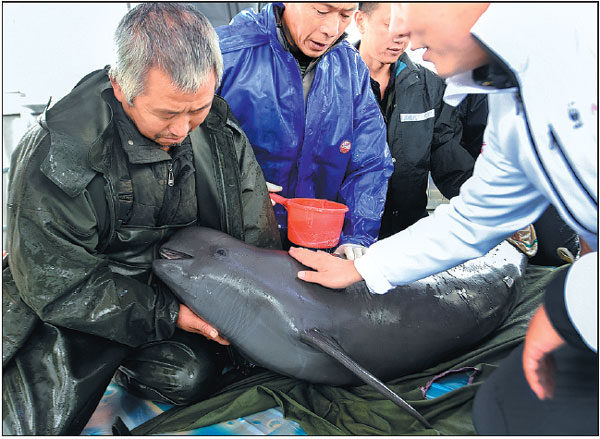Political advisers warn species could disappear within a decade
The endangered Yangtze finless porpoise has about a decade until extinction unless it is elevated to the nation's top-class protected species list, national political advisers from Hubei province warned.
"There are only about 1,000 finless porpoises left in the Yangtze River, fewer than the number of giant pandas," said Xu Xudong, deputy director of the Chinese Academy of Sciences' Institute of Hydrobiology. "If the number keeps dropping at the current speed, the species might be extinct in a decade."
Xu, along with nine other members of the National Committee of the Chinese People's Political Consultative Conference, made a joint proposal this year to lift the legal status of the finless porpoise, a rare freshwater mammal.
He said the national list for priority wildlife protection has remained almost the same since 1989, "but the situation of porpoises is totally different".
"When I was in college in Wuhan, Hubei province, in the late 1970s, we could easily see porpoises in the Yangtze River," said Li Chang'an, a professor of environmental geology at China University of Geosciences who signed the proposal.
"With the development of the shipping industry in the river, it's getting harder to protect them," Li said. "But we should by no means let the porpoises follow the path of the white-flag dolphin."
The white-flag dolphin, also known as baiji, was officially declared "functionally extinct" in the Yangtze River in 2006 after scientists decided the population was too small to reproduce effectively, leaving the Yangtze finless porpoise as the only mammal in the river.
A survey conducted by the Ministry of Agriculture, the Chinese Academy of Sciences and the World Wildlife Fund in 2012 showed the river's porpoise population stood at about 1,040. About 100 die every year, some as a result of human activity, but many others sustain serious injuries, according to WWF figures.
"However, no one has been punished in any way for killing porpoises," Xu said. "It is highly possible that our proposal will be adopted, as it has been a critical moment for the animal."
The revised wildlife-protection law, which took effect in January, "demands the list of wildlife of priority protection to be updated every five years".
As a first-class protected species, the government will pay more attention to the porpoises, more ordinary people will be aware of their situation and those who hurt the animal will be punished severely, Xu said. The porpoise's natural habitat is mainly the middle and lower reaches of the Yangtze River and two of its adjacent lakes, Poyang and Dongting.
Xu said unlike the breeding of pandas, the human-assisted breeding technology of the finless porpoise is not advanced.
"Half of the porpoises live in the main waterway of the Yangtze River. We can only expect those living in the Poyang and Dongting lakes to be well protected," he said.
He explained a proposed ban on fishing in the Yangtze River for a decade to restock fish species, "will also be good for the porpoises".
The issue has attracted public attention. In early February, thousands of people helped search for a porpoise with a hook in its back. (China Daily USA)
 |
|
Volunteer Xie Shoujun (left) helps to complete a health check of a Yangtze porpoise in the Tian'ezhou National Nature Reserve in Hubei province on Oct 24. The species is known as finless porpoise because it lacks a dorsal fin.Qi Heng / Xinhua |




